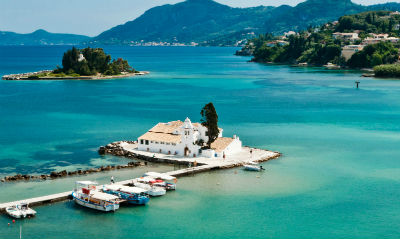Ionian Castles
The Best Ionian Islands Castles
Medieval castles and monasteries, mythical buildings and museums all point to the culture and rich history of the Ionian islands. In Corfu impress the Old and the New Fortress, Achilleos built by Empress Sisi, Mon Repos. Exceptional are the museums of the city and mainly the Asian Art at the Michael and George Palace, the Archaeological, the Municipal Art Gallery, etc. Famous are the Philharmonic of Corfu, but also the Easter on the island with the typical custom of the boots and the passing of the image of the patron saint of Saint Spyridon.
In Lefkada you will find one of the most prestigious medieval buildings in Greece and the most important attraction of the island: elevated at the entrance of the city of Lefkada from the 14th century, the impressive castle of Agia Mavra awaits you to discover it – while in the streets you will admire remarkable churches of the 17th and 18th centuries.
At a distance of 37 nautical miles from Zakynthos are Strofades, islands that “host” an impressive monastery of the 13th-century fortress form.
Medieval castles and monasteries, mythical buildings and museums all point to the culture and rich history of the Ionian islands. In Corfu impress the Old and the New Fortress, Achilleos built by Empress Sisi, Mon Repos. Exceptional are the museums of the city and mainly the Asian Art at the Michael and George Palace, the Archaeological, the Municipal Art Gallery, etc. Famous are the Philharmonic of Corfu, but also the Easter on the island with the typical custom of the boots and the passing of the image of the patron saint of Saint Spyridon.
In Lefkada you will find one of the most prestigious medieval buildings in Greece and the most important attraction of the island: elevated at the entrance of the city of Lefkada from the 14th century, the impressive castle of Agia Mavra awaits you to discover it – while in the streets you will admire remarkable churches of the 17th and 18th centuries.
At a distance of 37 nautical miles from Zakynthos are Strofades, islands that “host” an impressive monastery of the 13th-century fortress form.
The village of Assos with its Venetian castle, full of pine and cypress trees, the very city of Corfu, with the characteristic alleyways, Liston and Spianada, the largest square in the Balkans, is full of impressive buildings built by the Venetians, the French and British conquerors.
The most famous attraction of the Paxi island, the castle of Agios Nikolaos on the homonymous islet near the harbor of Gaios, has been declared a preserved monument. It began to be built in 1423 and was rebuilt in 1510 by the Venetians, according to Leonardo da Vinci’s plan still in the Archives of Venice.


